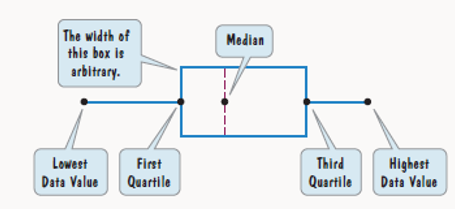
Concept explainers
a. Find the median murder rate per 100.000 residents for the 50 states and Washington, D.C
b. Find the first quartile by determining the median of the lower half of the data. (This is the median of the items that lie below the median that you found in part (a).)
c. Find the third quartile by determining the median of the upper half of the data. (This is the median of the items that lie above the median that you found in part (a).)
d. Use the following numerical scale:

Above this scale, show five points, each at the same height. (The height is arbitrary.)Each point should represent one of the following numbers:
lowest data value, first quartile, median, third quartile, highest data value
e. A box-arid-whisker plot consists of a rectangular box extending from the first quartile to the third quartile, with a dashed line representing the median, and line segments (or whiskers) extending outward from the box to the lowest and highest data values:

Use your graph from part (d) lo create a box-and-whisker plot for U.S. murder rates per 100,000 residents
f. If one of the whiskers in a box-and-whisker plot is clearly longer, the distribution is usually skewed in the direction of the longer whisker. Based on this observation, does your box-and-whisker plot in part (e) indicate that the distribution is skewed to the right or skewed to the left?
g. Is the shape of the distribution of scores shown by the given histogram consistent with your observation in part (f)?
Want to see the full answer?
Check out a sample textbook solution
Chapter 12 Solutions
EBK THINKING MATHEMATICALLY
- Solve y"+3y+2y= 0, y(0) = 3, y'(0) = -1 y(t) =arrow_forwardSolve 4y"-23y+15y = 0, y(0) = -8, y'(0) = -23 y(t) =arrow_forwardCar A starts from rest at t = 0 and travels along a straight road with a constant acceleration of 6 ft/s^2 until it reaches a speed of 60ft/s. Afterwards it maintains the speed. Also, when t = 0, car B located 6000 ft down the road is traveling towards A at a constant speed of 80 ft/s. Determine the distance traveled by Car A when they pass each other.Write the solution using pen and draw the graph if needed.arrow_forward
- The velocity of a particle moves along the x-axis and is given by the equation ds/dt = 40 - 3t^2 m/s. Calculate the acceleration at time t=2 s and t=4 s. Calculate also the total displacement at the given interval. Assume at t=0 s=5m.Write the solution using pen and draw the graph if needed.arrow_forwardThe velocity of a particle moves along the x-axis and is given by the equation ds/dt = 40 - 3t^2 m/s. Calculate the acceleration at time t=2 s and t=4 s. Calculate also the total displacement at the given interval. Assume at t=0 s=5m.Write the solution using pen and draw the graph if needed.arrow_forwardNo chatgpt plsarrow_forward
- 310015 K Question 9, 5.2.28-T Part 1 of 4 HW Score: 85.96%, 49 of 57 points Points: 1 Save of 6 Based on a poll, among adults who regret getting tattoos, 28% say that they were too young when they got their tattoos. Assume that six adults who regret getting tattoos are randomly selected, and find the indicated probability. Complete parts (a) through (d) below. a. Find the probability that none of the selected adults say that they were too young to get tattoos. 0.0520 (Round to four decimal places as needed.) Clear all Final check Feb 7 12:47 US Oarrow_forwardSolutions of inequalitie Google Classroom Mic Is (-3, 2) a solution of 7x+9y > -3? Choose 1 answer: A Yes B No Related content ▶6:06 Testing solutions to inequalities 2 of 4arrow_forwardcan you help me solve the parts and show workings pleasearrow_forward
- Suppose that a room containing 1300 cubic feet of air is originally free of carbon monoxide (CO). Beginning at time t = 0, cigarette smoke containing 4% CO is introduced into the room at a rate of 0.8 cubic feet per minute. The well-circulated smoke and air mixture is allowed to leave the room at the same rate. Let A(t) represent the amount of CO in the room (in cubic feet) after t minutes. (A) Write the DE model for the time rate of change of CO in the room. Also state the initial condition. dA dt A(0) (B) Solve the IVP to find the amount of CO in the room at any time t > 0. A(t) (C) Extended exposure to a CO concentration as low as 0.00012 is harmful to the human body. Find the time at which this concentration is reached. t= minutesarrow_forward2 18-17-16-15-14-13-12-11-10 -9 -8 -6 -5 -4-3-2-1 $ 6 8 9 10 -2+ The curve above is the graph of a sinusoidal function. It goes through the points (-10, -1) and (4, -1). Find a sinusoidal function that matches the given graph. If needed, you can enter π-3.1416... as 'pi' in your answer, otherwise use at least 3 decimal digits. f(x) = > Next Questionarrow_forward4. Use method of separation of variable to solve the following wave equation მłu J²u subject to u(0,t) =0, for t> 0, u(л,t) = 0, for t> 0, = t> 0, at² ax²' u(x, 0) = 0, 0.01 x, ut(x, 0) = Π 0.01 (π-x), 0arrow_forwardarrow_back_iosSEE MORE QUESTIONSarrow_forward_ios
 Big Ideas Math A Bridge To Success Algebra 1: Stu...AlgebraISBN:9781680331141Author:HOUGHTON MIFFLIN HARCOURTPublisher:Houghton Mifflin Harcourt
Big Ideas Math A Bridge To Success Algebra 1: Stu...AlgebraISBN:9781680331141Author:HOUGHTON MIFFLIN HARCOURTPublisher:Houghton Mifflin Harcourt Glencoe Algebra 1, Student Edition, 9780079039897...AlgebraISBN:9780079039897Author:CarterPublisher:McGraw Hill
Glencoe Algebra 1, Student Edition, 9780079039897...AlgebraISBN:9780079039897Author:CarterPublisher:McGraw Hill Holt Mcdougal Larson Pre-algebra: Student Edition...AlgebraISBN:9780547587776Author:HOLT MCDOUGALPublisher:HOLT MCDOUGAL
Holt Mcdougal Larson Pre-algebra: Student Edition...AlgebraISBN:9780547587776Author:HOLT MCDOUGALPublisher:HOLT MCDOUGAL


